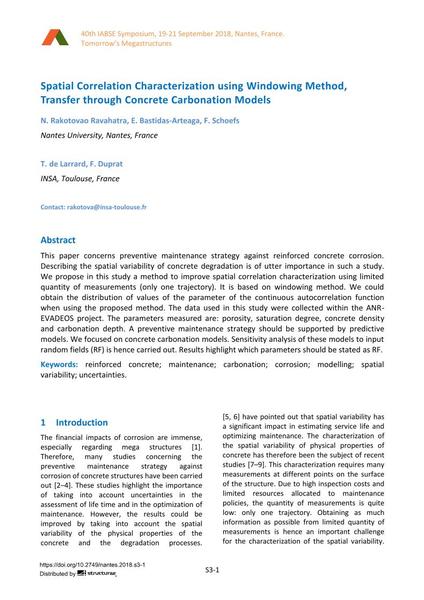Spatial Correlation Characterization using Windowing Method, Transfer through Concrete Carbonation Models

|
|
|||||||||||
Bibliographic Details
| Author(s): |
N. Rakotovao Ravahatra
(Nantes University, Nantes, France)
E. Bastidas-Arteaga (Nantes University, Nantes, France) F. Schoefs (Nantes University, Nantes, France) T. De Larrard (INSA, Toulouse, France) F. Duprat (INSA, Toulouse, France) |
||||
|---|---|---|---|---|---|
| Medium: | conference paper | ||||
| Language(s): | English | ||||
| Conference: | IABSE Symposium: Tomorrow’s Megastructures, Nantes, France, 19-21 September 2018 | ||||
| Published in: | IABSE Symposium Nantes 2018 | ||||
|
|||||
| Page(s): | S3-1 | ||||
| Total no. of pages: | 9 | ||||
| DOI: | 10.2749/nantes.2018.s3-1 | ||||
| Abstract: |
This paper concerns preventive maintenance strategy against reinforced concrete corrosion. Describing the spatial variability of concrete degradation is of utter importance in such a study. We propose in this study a method to improve spatial correlation characterization using limited quantity of measurements (only one trajectory). It is based on windowing method. We could obtain the distribution of values of the parameter of the continuous autocorrelation function when using the proposed method. The data used in this study were collected within the ANR- EVADEOS project. The parameters measured are: porosity, saturation degree, concrete density and carbonation depth. A preventive maintenance strategy should be supported by predictive models. We focused on concrete carbonation models. Sensitivity analysis of these models to input random fields (RF) is hence carried out. Results highlight which parameters should be stated as RF. |
||||
| Keywords: |
modelling corrosion reinforced concrete uncertainties maintenance carbonation spatial variability
|
||||
